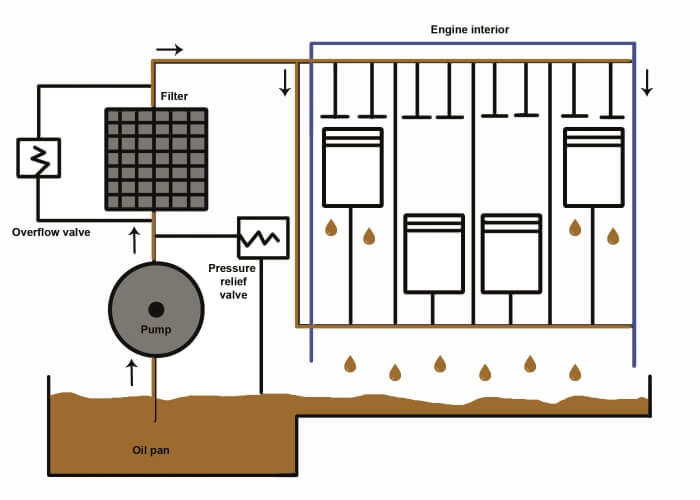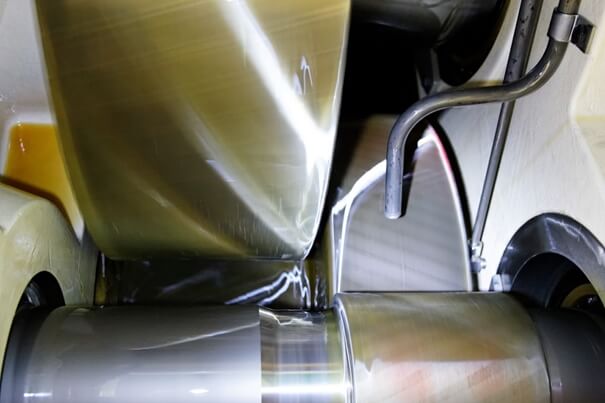


What is pressure lubrication?
Pressure lubrication (also known as injection lubrication) is a form of lubrication that uses one or more pumps to deliver oil to the lubrication points. The lubricant is distributed throughout the oil circuit. It is the most commonly used lubrication in engines. However, it is also used in other components such as gearboxes or compressors.
In the case of pressure lubrication, wet sump lubrication, in which the oil supply is collected and stored in the oil sump, is the most common design. Pressure lubrication can be divided into two systems, wet sump lubrication and dry sump lubrication. Both are possible, but differ in the application, storage of the oil supply and delivery of the oil.
How does wet sump lubrication work?
In a four-stroke engine, the oil is drawn from an oil sump by a pump, passed through a filter and fed into the engine compartment. If the main flow filter should become clogged, the overflow valve ensures that the oil flow is maintained. The lubricant reaches all relevant lubrication points such as connecting rods, crankshaft and camshaft through sufficient pressure. The rotation of the crankshaft ensures that oil is distributed to the cylinder liners and connecting rod bearings. The rotation of the crankshaft creates an additional oil mist in the crankcase. This helps to cool the piston crown. When the oil has passed through the interior of the engine, it flows back into the oil pan, cools down and is pumped into the oil circuit again.

How does dry sump lubrication work?
In dry sump lubrication, the lubricant is stored in a special tank. From there, the oil reaches the lubrication points via a pump. The oil drips off the lubrication points and forms an oil sump. This oil sump is sucked in by a second pump (suction pump) and returned to the tank. A lubrication circuit is created.
What is dry sump lubrication needed for?
Dry sump lubrication is used on very sporty vehicles. The vehicles generate high centrifugal forces which can lead to air being sucked in from the oil sump and the oil circuit being interrupted in the case of wet sump lubrication. Especially with these high-performance machines, insufficient lubrication can quickly lead to engine damage. Here, dry sump lubrication is often used, which guarantees a more stable lubricating film.
Besides sporty cars, many aircraft engines are also equipped with dry sump lubrication. The higher the power of the machine, the more useful dry sump lubrication can become.
Advantages and disadvantages of wet sump lubrication and dry sump lubrication
| Advantages | Disadvantages | |
| Wet sump lubrication |
|
|
| Dry sump lubrication |
|
|
What are the advantages of pressure lubrication?
The pressure from the oil pump ensures that even the most distant lubrication point can be supplied with oil. The design of the system is efficient and comparatively cheap. As a result, a smaller amount of oil is needed in the engine. At the same time, a compact engine design reduces the overall weight of the vehicle. Regardless of the operating status of the unit, almost constant, reliable lubrication is ensured (in industrial systems, lubrication is switched on before the unit is started).
What are the disadvantages of pressure lubrication?
Pressure lubrication involves general problems which can be solved by certain design adjustments or the optimum lubricant.
When the oil enters the engine compartment, it reaches the crankshaft or the cylinder head on its way back to the oil pan. The lubrication points between these areas are not lubricated at first. This applies to connecting rod bearings, connecting rods and cylinder liners. In order to cover these lubrication points with a lubricating film, drill holes must be made in the crankshaft or special spray nozzles must be installed.
When the engine is cold, the oil pressure can become very high because the oil is still very viscous and difficult to pump. Pressure peaks can occur that cause damage to the oil circuit. These pressure peaks are to be mitigated by the built-in pressure relief valves.
In modern industrial systems, the performance and compactness of the circulation system are measured in terms of how many minutes it takes to circulate the total volume of oil. In the past, it often took hours in turbine systems to pump the total amount of oil (large oil volume). Nowadays, it takes only two to three minutes (small volume, high pump output) for the entire oil volume to be pumped into the lubrication system. The disadvantage of this is the short settling time, which can lead to foam, cavitation and/or vibrations.
Our tip:
If you have problems with foam and vibrations in your system, the ADDINOL GLS series can help. For cavitation we recommend the turbine oils MT 32 and MT 46.
In industrial gearboxes, the spray effect is hardly present, also because of the lower speeds and relative movements in the system. There, the systems are harmonised in such a way that the oil flows off evenly and effectively with as little air input as possible. Another form of gearbox lubrication is splash lubrication.

Contact
